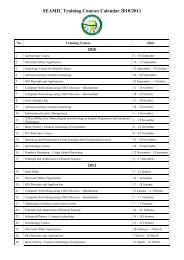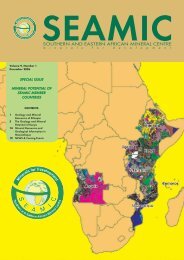SEAMIC Newsletter Vol. 10
SEAMIC Newsletter Vol. 10
SEAMIC Newsletter Vol. 10
You also want an ePaper? Increase the reach of your titles
YUMPU automatically turns print PDFs into web optimized ePapers that Google loves.
Mubende area, pegmatites have been found to contain the mineral. Major columbite-tantalite<br />
deposits in Uganda include Kakanena, Jemubi, Nyanga and Ngoma-Kazumo with up to 83%<br />
Ta 2 O 5 and 70% Nb 2 O 5 . The most important niobium mineral is pyrochlore which occurs in<br />
carbonatites at Sukulu (130 million tones at 0.2% Nb 2 O 5 ) and Butiru in east and at Napak and<br />
Toror in Karamoja.<br />
Bismuth: Bismuthite and native bismuth occur in highly oxidized veins and bodies emplaced<br />
in rocks of the Karagwe-Ankolean System close to the Kayonza granite intrusive. The most<br />
prospective location is Rwanzu, and others are Muramba, Kyambeya, Rwenkuba, Kitawulira,<br />
Kitwa and Nyakashunzu.<br />
Manganese: Manganese-ore occurrences have been found in Isandara, Gulika, Kirongo and<br />
Gweitengya in western region.<br />
Radioactive minerals and REE: Potential favourable geological environment for radioactive<br />
mineral enrichment are the eastern Uganda carbonatite complexes, the Uganda volcanic fields,<br />
the granitised domes of eastern and western Uganda, the fault zones and the adjacent highlands<br />
of western and northern Uganda.<br />
Industrial Minerals (Non-Metallic Minerals)<br />
Carbonate rocks: Carbonatite centres include: Bukiribo (16.5 million tonnes), Sukulu<br />
(Magnesia >3.5% and P 2 O 5 ~3.7%), Napak, Toror and Lolekek. Limestone include: Hima<br />
limestone (about 18 million tonnes) and Muhokya and Dura limestone deposits.<br />
Phosphates: Phosphates occur in the Eastern Carbonatite complexes and in the overlying<br />
residual soils as apatite at Sukulu (230 million tonnes at 12.8% P 2 O 5 ) and Busumbu. Over<br />
160,000 tonnes of apatite concentrate for Single Super Phosphate (SSP) fertilizer were<br />
extracted from residual soils. Reserves of 3 million tonnes at 11% P 2 O 5 and 5.5 million tonnes<br />
at 15% P 2 O 5 with acceptable levels of silica, Mg, Cd and Pb were estimated at Busumbu.<br />
Feldspars: Feldspars occur in pegmatites of which small amounts have so far been mined at<br />
Bulema and Nyabakweri Mines and Lunya for ceramics production. Also a number of<br />
pegmatites with a high possibility of recoverable quantities of feldspar for example at Mutaka<br />
occur in South-Western Uganda.<br />
Kaolin: Kisai/Kooki, and Namasera kaolin is known to have been formed by alteration of<br />
sedimentary shales and about 2.5 million tonnes and 64,000 tonnes of good material for<br />
ceramics has been estimated respectively. At Mutaka the kaolin deposit is associated with<br />
pegmatites. Other kaolin occurrences which are kaolinised granitoids are located at Buwambo<br />
and Migade.<br />
Salts: Best known reserves are located in the lake brines of Lake Katwe (2.5 km 2 and 0.75 m<br />
depth) located on the Northern shore of Lake Edward in the Western Rift Valley. The lake<br />
constitutes of about 22.3 tonnes of mixed salts (i.e. NaCl - 8%, NaSO 4 - 9%, KSO 4 - 3%, KCl<br />
- 2% and KBr - 2%).<br />
Gypsum: Gypsum occurs in the Quaternary sediments at Kibuku (12 million tones of<br />
gypsiferrous clay worth 1.2 million tonnes of gypsum concentrate at 85% gypsum), Lake<br />
Mburo (1.1M tones of gypsiferrous clay worth 290,000 tonnes of gypsum concentrate at 60-<br />
70% gypsum) and Muhokya (3.2 million tonnes of gypsiferrous clay capable of producing<br />
40,000 tonnes of gypsum concentrate at 86-90% gypsum).<br />
Silica Sand: Beaches of white sand formed from erosion of quartzites in the basement and cover<br />
sequences occur in several places along the shores of Lake Victoria. Grain size analysis data<br />
19




